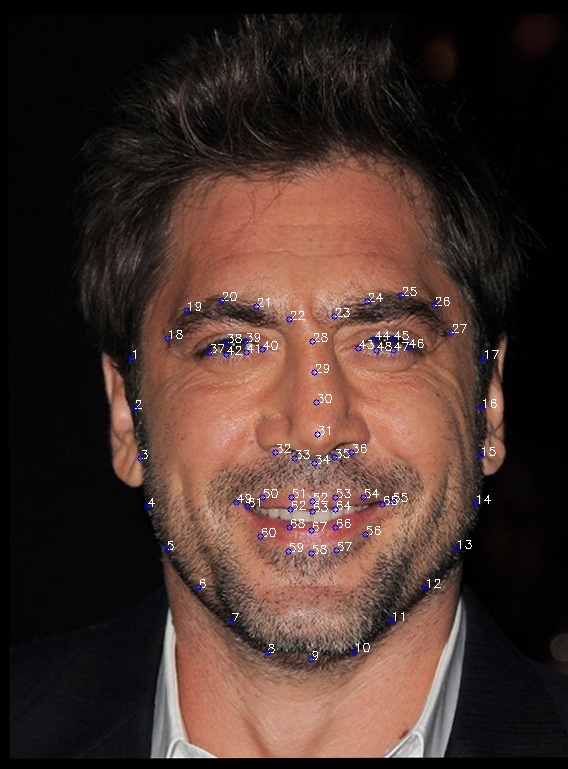Face Morphing
Written on October 18th, 2018 by Andrew Campbell
This post explores face morphing in Python using OpenCV and Dlib. I walk through the process of creating face-movie, a tool I made to automatically create a morph video from a given set of images. It can be used, for example, to create a music video showing someone’s face change over the years. Along the way, we also explore computing an average face from a population.
Introduction
The goal of a face morph is to transform one face image into another as seamlessly as possible. To do this, we will need to compute “in-between” faces that begin as the first image and transition into the second image. Naively, this can be achieved with alpha blending: given two images \( A \) and \( B \), compute a blended image \( C \) as follows:
for \( 0 \leq \alpha \leq 1 \). Varying \( \alpha \) from 0 to 1 will produce a cross-dissolve sequence. Of course, this isn’t going to look good. We need facial features to be aligned for this to work. To achieve this, we need first establish pixel correspondences. From there, we can transform the two faces into their average geometry. Then we can simply cross-dissolve the colors as before.
Now let’s look into this procedure in detail.
1. Correspondences
Let’s say we want to morph the following pictures of Jeffrey Dean Morgan and Javier Bardem, perhaps just to prove how that they’re practically the same person.


We first need pairs of corresponding points. Correspondences should map eyes to eyes, mouth to mouth, chin to chin, ears to ears, etc. The labeling must be consistent, i.e. the keypoints in the two images must appear in the same order.
This would be tedious to do manually. Luckily there is a great software library called Dlib with support for automatic facial landmark detection. Dlib implements the algorithm described in the paper One Millisecond Face Alignment with an Ensemble of Regression Trees by Vahid Kazemi and Josephine Sullivan. The predictor requires a pre-trained model which can be downloaded here.
Shown below are the 68 facial landmarks automatically detected in our example images:


2. Triangulation
We can compute the average geometry of the correspondences by simply averaging each pair of points. Now, we have a handful of points that match up in each face, but the rest of the correspondences are unknown. One way we can solve this is by breaking the images into smaller patches by computing the Delaunay triangulation on the averaged correspondences. A Delaunay triangulation is a particularly good choice because it does not produce overly skinny triangles, which helps minimize distortions. I let scipy.spatial.Delaunay do all the magic here.
Note that before doing the Delaunay triangulation, we need to append boundary points of the images to the set of correspondences. I used the corners of the image and half-way points between those corners. This is done in order to ensure the entire image is contained within some triangle.
Overlaying the average triangulation onto our images, we now have the following:


3. Producing the Mid-way Face
We’re now ready to perform affine transformations on the triangles to morph the faces into the average geometry. The idea is to pick a triangle in the source image and the corresponding triangle in the destination triangulation (which is just the averaged triangulations of the two images). Then we calculate the affine transform that maps the three corners of the triangle to the three corners of the corresponding triangle in the morphed image. We do this for each pair of triangles.
I used the approach suggested here for transforming all pixels inside a triangle to the morphed image. The idea is to calculate a bounding box for the triangle, warp all pixels inside the bounding box, and then mask the pixels outside the triangle.
Once we’ve morphed both images into the average geometry, we can simply cross-dissolve them to produce a “mid-way” face. The mid-way face is shown center below:



4. Creating a Morph Sequence
To produce a morph sequence, we simply vary \( \alpha \) from 0 to 1. This time, \( \alpha \) controls both the weighting of the correspondences (i.e. shape) and pixel values (i.e. color). I used ffmpeg to help with the video creation. The resulting morph is shown below.

Creating a Face Movie
Now that we could create pairwise morphs, a movie was the next step. I wanted to make something similar to the (now deprecated) “face movie” feature of Picassa, which automatically aligned face images and cross-dissolved them.
The first step was to align the input images by face. I adapted some of the code from here for this purpose. It uses something called a procrustes analysis to find an affine transformation matrix by considering all pairs of facial correspondences. I save the aligned results from this step into a temporary directory. For aesthetics, I overlay images on top of each other and added a thin white border.
We could stop here and simply cross-dissolve the faces; that’s what Picassa did. But we can go further by applying our face-warping procedure to the aligned face images.
Here are some examples of music videos created using this approach.
Averaging Faces
A simple yet amusing extension of the code thus far allows us to compute the average face from a set of images. To demonstrate, I downloaded a subset of headshots from faceresearch.org - 30 photos of men and 30 photos of women, most of whom are young and lighter-skinned.


To compute the average face, I found correspondences for each subset (using the automatic method described later), computed the average geometry, warped each image into the average geometry, then averaged the pixel values.
The average face over all men (left) and women (right) are shown below.


The Code
The code and download instructions can be found here.
© Andrew Campbell. All Rights Reserved.